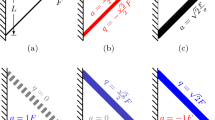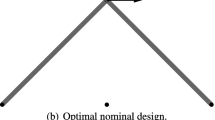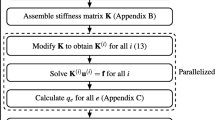Abstract
To investigate the characteristics of optimal fail-safe structures subjected to single and multi-member damage scenarios, we consider a pin-jointed cantilever truss with all members directly connected from the load point to the boundary. Two problem formulations are considered—minimizing the compliance with a volume constraint and minimizing the volume with stress constraints. Whilst these formulations produce equivalent structures for traditional truss design problems, we find that this is not always the case in the fail-safe setting. Analytical solutions are developed for a three-bar truss under both problem formulations. Damage is modelled as the complete removal of any one member, and a minmax problem is constructed to minimize the compliance or volume of the structure for the worst-case damage scenario. These new analytical solutions provide much needed benchmarks for numerical fail-safe methods. The problems are extended to n-bar systems with damage to multiple members. Results show that as the structural complexity (the number of members in a system) increases, the optimum fail-safe structure tends towards a variation of the nominal two-bar design with overlapping members. From these observations, we then approach the idea of full redundancy through the introduction of parallel substructures into a more complex truss design. We compare our fully redundant truss design with a benchmark fail-safe solution and show that the fully redundant design has significantly better performance and with fewer members. Practically, this suggests that fully redundant structural designs are highly efficient and have the additional benefit of only requiring the computation of the nominal solution.
摘要
本文通过分析一个构件直接连接的铰接悬臂桁架, 研究在单、 多构件破损情况下的最优破损-安全结构的特性. 考虑两种优化问题: 通过体积约束实现柔度的最小化和通过应力约束实现体积的最小化. 虽然这些公式为传统桁架设计问题生成了等效结构, 但我们发现在破损-安全设置中并不总是如此. 文章在这两种优化问题下给出了三杆桁架结构的解析解. 文章在建模时将破坏定义为完全移除任何一个构件, 并构造一个极小-极大问题来实现在最坏破损情形下的柔度最小化或体积最小化. 最小化结构的柔度或体积. 新的解析解为破损-安全的数值设计方法提供了急需的参考. 该问题被推广到多构件受损的n杆系统. 结果表明, 随着结构复杂性(系统中构件 的数量)的增加, 最优的破损-安全结构倾向于转化为具有重叠构件的名义上的双杆设计. 基于文章观测结果, 作者随后在更复杂的桁架设计中通过引入平行子结构来实现完全冗余的想法. 我们将全冗余桁架设计与破损-安全设计方案进行比较, 结果表明全冗余桁架设计明显具有更优的性能且需要更少的构件. 这表明完全冗余的结构设计高效可行, 并且只需要计算名义设计方案.
Similar content being viewed by others
References
Y. Kanno, and Y. Ben-Haim, Redundancy and robustness, or when is redundancy redundant? J. Struct. Eng. 137, 935 (2011).
D. P. Mohr, I. Stein, T. Matzies, and C. A. Knapek, Redundant robust topology optimization of truss, Optim. Eng. 15, 945 (2014).
P. F. Sun, J. S. Arora, and E. J. Haug Jr., Fall-safe optimal design of structures, Eng. Optim. 2, 43 (1976).
J. S. Arora, A. K. Govil, and D. F. Haskell, Optimal design of large structures for damage tolerance, AIAA J. 18, 563 (1980).
D. T. Nguyen, and J. S. Arora, Fail-safe optimal design of complex structures with substructures, J. Mech. Des. 104, 861 (1982).
M. Stolpe, Fail-safe truss topology optimization, Struct. Multidisc. Optim. 60, 1605 (2019).
W. Achtziger, M. P. Bendsøe, and J. E. Taylor, Bounds on the effect of progressive structural degradation, J. Mech. Phys. Solids 46, 1055 (1998).
W. Achtziger, and M. P. Bendsøe, Optimal topology design of discrete structures resisting degradation effects, Struct. Optim. 17, 74 (1999).
D. M. Frangopol, and J. P. Curley, Effects of damage and redundancy on structural reliability, J. Struct. Eng. 113, 1533 (1987).
W. M. Sebastian, Collapse considerations and electrical analogies for statically indeterminate structures, J. Struct. Eng. 130, 1445 (2004).
J. Z. Du, F. W. Meng, Y. H. Guo, and Y. K. Sui, Fail-safe topology optimization of continuum structures with fundamental frequency constraints based on the ICM method, Acta Mech. Sin. 36, 1065 (2020).
J. Du, Y. Guo, Z. Chen, and Y. Sui, Topology optimization of continuum structures considering damage based on independent continuous mapping method, Acta Mech. Sin. 35, 433 (2019).
M. Jansen, G. Lombaert, M. Schevenels, and O. Sigmund, Topology optimization of fail-safe structures using a simplified local damage model, Struct. Multidisc. Optim. 49, 657 (2014).
M. Zhou, and R. Fleury, Fail-safe topology optimization, Struct. Multidisc. Optim. 54, 1225 (2016).
X. Peng, and Y. Sui, Lightweight topology optimization with consideration of the fail-safe design principle for continuum structures, Eng. Optim. 53, 32 (2021).
H. Wang, J. Liu, G. Wen, and Y. M. Xie, The robust fail-safe topological designs based on the von Mises stress, Finite Elem. Anal. Des. 171, 103376 (2020).
O. Ambrozkiewicz, and B. Kriegesmann, in Adaptive strategies for fail-safe topology optimization: Proceedings of the International Conference on Engineering Optimization (Springer, Cham, 2018), pp. 200–211.
O. Ambrozkiewicz, and B. Kriegesmann, Density-based shape optimization for fail-safe design, J. Comput. Des. Eng. 7, 615 (2020).
Y. Kanno, Worst scenario detection in limit analysis of trusses against deficiency of structural components, Eng. Struct. 42, 33 (2012).
Y. Kanno, Redundancy optimization of finite-dimensional structures: Concept and derivative-free algorithm, J. Struct. Eng. 143, 04016151 (2017).
J. K. Lüdeker, and B. Kriegesmann, Fail-safe optimization of beam structures, J. Comput. Des. Eng. 6, 260 (2019).
A. Serafinska, K. özenç, and M. Kaliske, A coupled approach of optimization, uncertainty analysis and configurational mechanics for a fail-safe design of structures, Int. J. Numer. Meth. Engng 109, 125 (2017).
C. Cid, A. Baldomir, and S. Hernández, Probability-damage approach for fail-safe design optimization (PDFSO), Struct. Multidisc. Optim. 62, 3149 (2020).
C. Cid Bengoa, A. Baldomir, S. Hernández, and L. Romera, Multimodel reliability-based design optimization of structures considering the intact configuration and several partial collapses, Struct. Multidisc. Optim. 57, 977 (2018).
K. Marhadi, and S. Venkataraman, Surrogate measures to optimize structures for robust and predictable progressive failure, Struct. Multidisc. Optim. 39, 245 (2009).
Y. Murotsu, S. Shao, and A. Watanabe, An approach to reliability-based optimization of redundant structures, Struct. Saf. 16, 133 (1994).
K. S. Marhadi, S. Venkataraman, and S. A. Wong, Load redistribution mechanism in damage tolerant and redundant truss structure, Struct. Multidisc. Optim. 44, 213 (2011).
S. M. O. Tavares, and P. M. S. T. de Castro, Damage Tolerance of Metallic Aircraft Structures: Materials and Numerical Modelling (Springer, Berlin/Heidelberg 2019).
W. Dorn, R. Gomory, and H. Grenberg, Automatic design of optimal structures, J. de Mecanique 3, 25 (1964).
W. Achtziger, Truss topology optimization including bar properties different for tension and compression, Struct. Optim. 12, 63 (1996).
K. Mela, and J. Koski, On the equivalence of minimum compliance and stress-constrained minimum weight design of trusses under multiple loading conditions, Struct. Multidisc. Optim. 46, 679 (2012).
MATLAB’s Optimization Toolbox (2018). The MathWorks, Natick, MA, USA.
G. Sved, and Z. Ginos, Structural optimization under multiple loading, Int. J. Mech. Sci. 10, 803 (1968).
U. Kirsch, On singular topologies in optimum structural design, Struct. Optim. 2, 133 (1990).
Author information
Authors and Affiliations
Corresponding author
Additional information
This work was supported by an Australian Government Research Training Program (RTP) Scholarship.
Rights and permissions
About this article
Cite this article
Kirby, J., Zhou, S. & Xie, Y.M. Optimal fail-safe truss structures: new solutions and uncommon characteristics. Acta Mech. Sin. 38, 421564 (2022). https://doi.org/10.1007/s10409-022-09028-3
Received:
Accepted:
Published:
DOI: https://doi.org/10.1007/s10409-022-09028-3




